#Allen Memorial Institute
Explore tagged Tumblr posts
Link
Scientific genocide
#Canada#MK-ULTRA#human experiments#indigenous children#Royal Victoria Hospital#Allen Memorial Institute#McGill University#CIA#Ewen Cameron#Mohawk Mothers#medical misconduct#psychiatry
0 notes
Text
June 22, 2023
On September 30th 2023, tomorrow on Truth and Reconciliation Day, and Every Child Matters Day, the Kahnistensera (Mohawk Mothers) will be holding a protest with McGill students at the Royal Victoria Hospital starting at 12PM.
Background information for the cause: There is credible evidence for the Mohawk mothers in question to believe their children have unmarked graves on the grounds of the RVH, where their children disappeared following human experimentation conducted on them by the Allan Memorial Institute on that site. The superior court has granted injunctions for the grieving mothers and their organization to investigate the grounds before McGill decides to build on top of the unmarked graves, as then it would be desecrating sacred ground. McGill University has broken the law multiple times by pursuing construction on the site despite credible preliminary evidence of human remains beneath the soil.
More information here:
English Pamphlet.
French Pamphlet.
The Conservation Article.
Mohawk Mothers.
Tagging: @politicsofcanada, @vague-humanoid, @mon-t-real
371 notes
·
View notes
Text

Writer/photographer/performer/club promoter and legend of New York's art & club circuits Gerry Visco, here shot by her friend, DJ & photographer Bobby Busnach in a SEX Cowboys t-shirt and leather miniskirt at the Park Royal, NYC, back in 1976.
According to Paul Gorman 's source post on his site: "…We lived at The Park Royal,” says Visco, who later appeared in Woody Allen’s 1980 movie Stardust Memories. “It didn’t have a cool scene. It was a residential hotel in a neighborhood on the Upper West Side which at the time was considered somewhat dangerous, a la Panic In Needle Park, but we lived across from The Dakota, where we often caught glimpses of people like John Lennon and Yoko Ono, Mia Farrow, Lauren Bacall, Roberta Flack and other celebrities.” From the turn of the 70s Busnach and Visco socialised in Boston and Manhattan as prominent figures in the gay disco and post-glam/pre-punk crowds. Meantime Busnach’s experiences as a DJ placed him dead centre of the scene out of which hip-hop grew. Visco attended New York’s Fashion Institute Of Technology and wore her own designs. She also sourced clothes from such labels as Fiorucci, Charles Jourdan and Malcolm McLaren and Vivienne Westwood’s SEX, which was sold through Ian’s at East 61st Street and Second Avenue. “Keep in mind that I am an UPTOWN BITCH – always have been and always will be!”exclaims Visco. “Downtown is for POSERS. Ha ha. The Ian’s on the UES was really good – the owner was always there and I bought some great stuff. I also worked in Macy’s briefly in the early 1980s in the cosmetics buying office. “As well as Ian’s I bought a lot of my clothes in vintage shops and at Henri Bendel’s, Bloomingdale’s and Bergdorf Goodman,” adds Visco, who also visited the UK where she bought McLaren/Westwood designs direct at 430 King’s Road…"
(via)
80 notes
·
View notes
Text
Zatanna, Wonder Woman and Barry Allen go undercover in this issue of DC Retroactive: JLA- The 70's #1 (2011) and Diana is absolutely terrible at it:

For those who don't know DC Retroactive are untold stories set in past continuities mostly by writers from those eras.
This issue was written by Carey Bates with art by Andy Smith.
(Side note: While Diana being 'bad' at going undercover is just a two page gag, it makes more sense for me that Diana, former 'Goddess of Truth' and wielder of the Lasso of True wouldn't be comfortable with secret identities. I never liked the idea of Diana needing a secret identity. )
The plot of this issue mainly revolves around Adam Strange, who is accidentally transported to Earth Prime following a fight with Kanjar Ro so Barry, Diana, Zatanna and Ollie travel to Earth Prime to rescue him while Hawkman and Green Lantern (Hal Jordan) take on the newly empowered Kanjar Ro.
Earth-Prime is basically "our world" where the JLA are all fictional characters and the writers and creators exist on that earth. It's also the world where Superboy Prime originally came from. Since Adam had his mind zapped at a mental institute, the only solution is to find DC editor and Adam Strange super fan Julius Schwartz who can jog Adam's memory.
I'm not really a fan of creators writing themselves or their collegues into the story. It feels very self congratulatory. Especially since WW's lasso could have solved the whole thing. I much prefer how Marvel did it, like an Easter Egg, where Stan and Jack would sometimes appear as themselves in issues of Fantastic Four. But I guess you can look at this issue as Carey's tribute to Schwartz. This issue also came with a reprint of Justice League of America #123 where Carey Bates wrote himself (or rather his Earth Prime counterpart) as the villain of the story.
Adam Strange himself is a character that I have mixed feelings about. He's very much a product of his time but the ordinary guy with a space suit, jetpack and helmet really appeals to the young boy in me who loved the Rocketeer. I don't think anyone has ever quite figured out how to make him relevant today. Tom King tried in his mini but it was the usual trope of 'lets reveal this innocent Silver Age character is actually a horrible person' variety of reinvention.
Anyway, enough rambling, since this is a Zatanna blog, here is a few moments with her that I like:
-The League chilling on the tower, Diana looks like she is oogling at Zee plus Hal being a Pink Floyd fan:
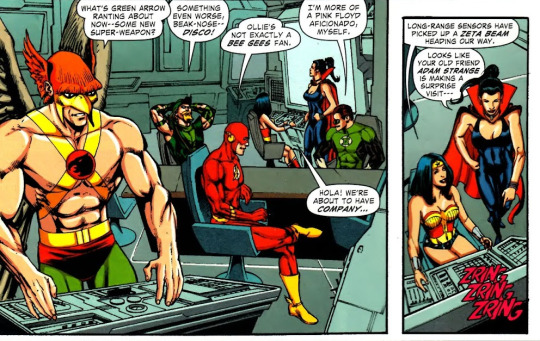
-Zatanna and Barry interactions plus Barry taking a leader ship role:

-This bit about mind wipes:
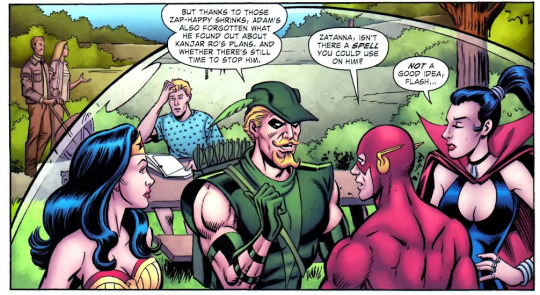
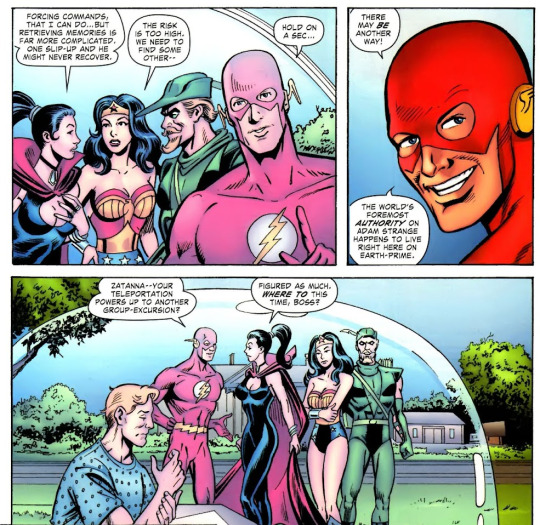
Knowing how much of a nerd Barry is he probably folded inside when she called him boss.
Also while this was most likely an excuse to bring in Julius Schwartz, Zatanna not tampering with minds is more in character for her during this period especially since the arc with her mom also had a subplot of her being mad that her father played with her mind. Another point deducted from Identity Crisis.
Blink and you miss it panels where the artist is clearly showing off their ability to draw human body in perspective:
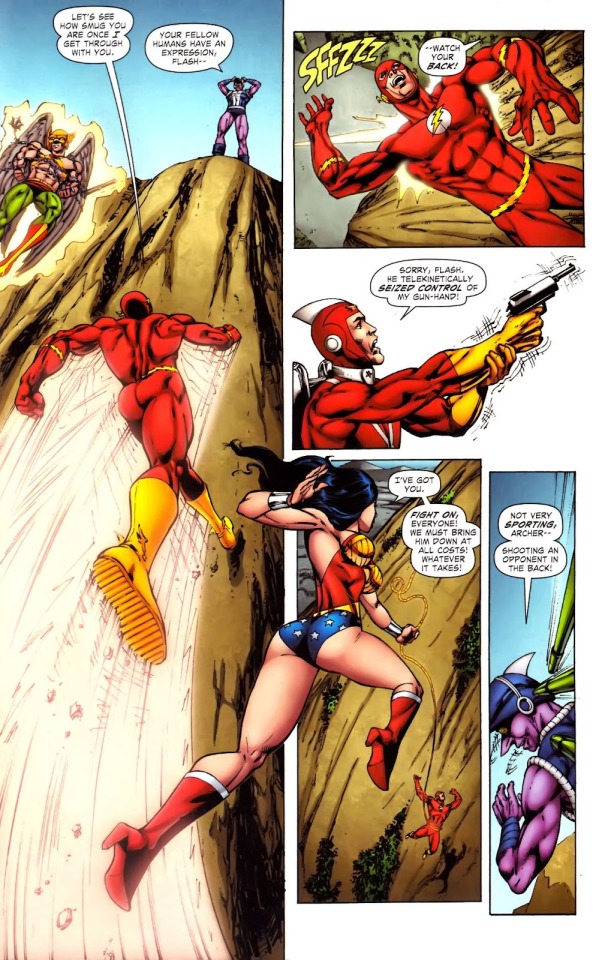
And Diana wanting to take a selfie after the League defeats Kanjar Ro:
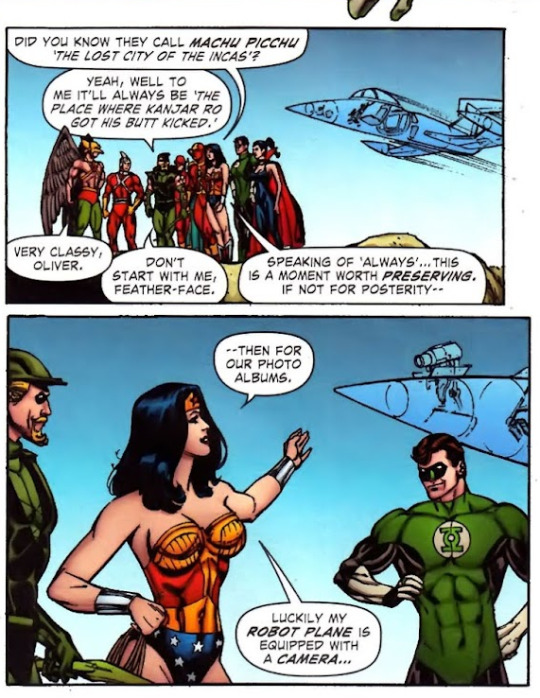
(also Diana's clearly a history geek, only a history geeks would drop random facts about Incas completely unprompted):
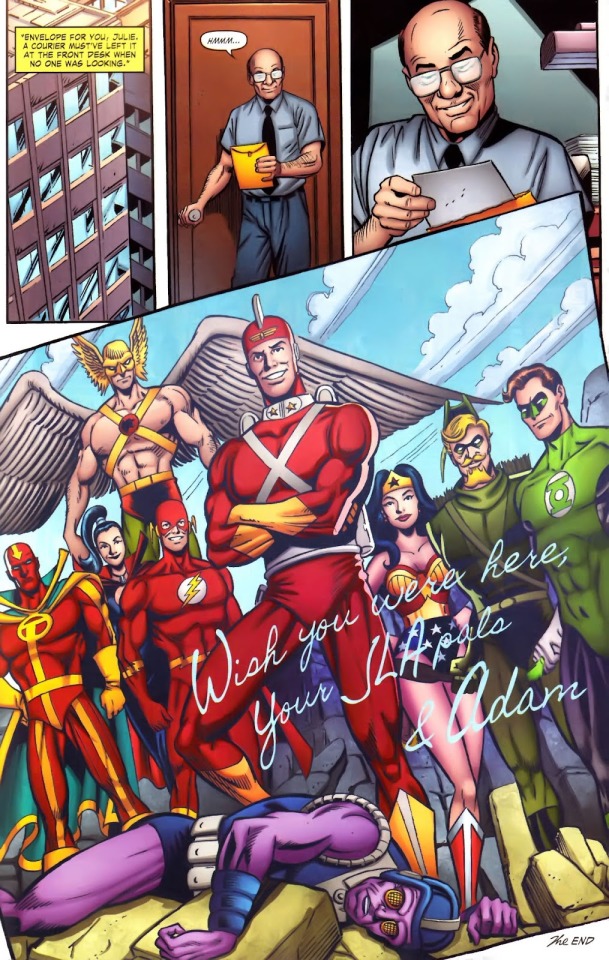
Overall, it's an old school issue. Very much a throwback. Still it's noteable that the writer of this issue didn't do the almost obligatory 'Zee gets gagged or taken out early so other characters can shine' plot. Every one has a role and everyone contributes their fair share to help defeat the villain.
#zatanna#zatanna zatara#wonder woman#diana of themyscira#flash#barry allen#adam strange#green arrow#oliver queen#hawkman#katar hol#green lantern#hal jordan#justice league of america#dc retroactive justice league of america the 70's#carey bates#julius schwartz#andy smith
31 notes
·
View notes
Photo






Post 0573
Jacob Allen Barber, Oklahoma inmate 2007100. born 1997, incarceration intake 01/06/2023 at age 25, Sentenced to life without the possibility of parole.
Murder
In January 2023, a 25-year-old man convicted of killing his father was sentenced to spend the rest of his life in prison.
Cleveland County District Judge Michael Tupper followed a jury’s recommendation and sentenced Jacob Allen Barber, 25, to life without the possibility of parole as punishment for killing Glenn Barber, 48.
Glenn Barber, his father, was the former youth pastor at First Moore Baptist Church.
Tupper called the case “a real tragedy.”
“The jury has clearly spoken in this case,” he said. “They had an option of doing something less in this case given the evidence they heard, and they were quite deliberate in this sentence.”
A jury in September 2022 found Barber guilty of stabbing his father to death in the summer of 2019. He was arrested near Sanger, Texas, and brought back to the Cleveland County Detention Center.
Court records indicated the father and son “argued daily and had a volatile relationship.”
“The suspect has been to several mental institutions but refuses to take his prescribed medication,” a detective wrote in a court affidavit.
After a 7-day trial, jurors voted unanimously to recommended a sentence of life without the possibility of parole and a $10,000 fine.
The trial was delayed several times due to the pandemic and for mental health evaluations. Much of the testimony during the trial centered on Barber’s mental state.
But lead prosecutor Abby Nathan argued Barber’s actions were premeditated.
“It is important to show the circumstances and the manner of this homicide,” she told jurors. “It is our duty and honor to the jury to do so.”
Two family members attended the hearing Friday but neither addressed the court.
The defendant also declined to speak.
“We know that there isn’t anything that anyone can do to change what happened, but we believe that the collaboration between the different agencies to bring justice for the victim, Glen Barber, honors Mr. Barber’s memory,” Nathan said in a statement following the hearing.
“During the trial there was one commonality among the testimonies of Mr. Barber’s family and friends. They all said he was an incredible person. We hope to honor and remember Mr. Glen Barber in that way, as the incredible person he was.”
3y
59 notes
·
View notes
Text
War Profiteers
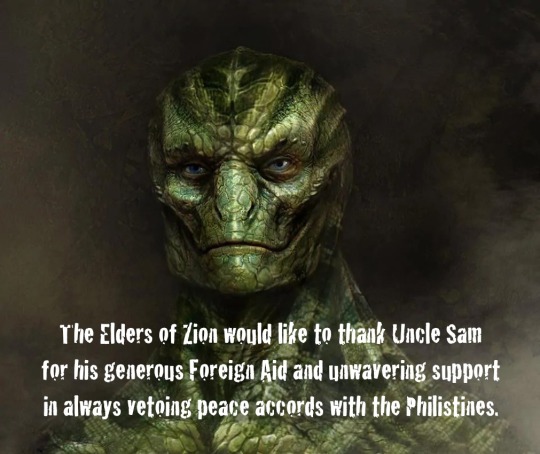
Remember President Dwight “Ike” Eisenhower, who after green-lighting the overthrow of Iran’s democracy in 1953 at the behest of petrochemical corporations, had a change of heart and warned about the Military Industrial Complex? Here are the top 100 USA Military Industrial Complex “defense” contractors, all corporate welfare queens mooching off the public, who have blood on their hands in Palestine and elsewhere:
Academi
Action Target
ADT Corporation
Advanced Armament Corporation
AECOM
Aerospace Corporation
Aerovironment
AirScan
AM General
American Petroleum Institute
Argon ST
ARINC
Artis
Assett
Astronautics Corporation of America
Atec
Aurora Flight Sciences
Axon Enterprise
United Kingdom BAE Systems
BAE Systems Inc
Ball Corporation
Ball Aerospace & Technologies
Barrett Firearms Manufacturing
Battelle Memorial Institute
Bechtel
Berico Technologies
Boeing Defense, Space & Security
Booz Allen Hamilton
Boston Dynamics
Bravo Strategic
CACI
Carlyle Group
Carnegie Mellon University
Ceradyne
Cloudera
Colt Defense
The Columbia Group
Computer Sciences Corporation
Concurrent Technologies Corporation
CSRA (IT services company)
Cubic Corporation
Omega Training Group
Curtiss-Wright
DeciBel Research
Dillon Aero
Dine Development Corporation
Draper Laboratories
DRS Technologies
DynCorp
Edison Welding Institute
[Israei]l Elbit Systems
M7 Aerospace
Ensco
United Kingdom/Military contractor Ernst & Young
Evergreen International Aviation
Exxon
Fluor Corporation
Force Protection Inc
Foster-Miller
Foster Wheeler
Franklin Armoury
General Atomics
General Dynamics
Bath Iron Works
General Dynamics Electric Boat
Gulfstream
Vangent
General Electric Military Jet Engines Division
Halliburton Corporation
Health Net
Hewlett-Packard
Honeywell
Humana Inc.
Huntington Ingalls Industries
Hybricon Corporation
IBM
Insight Technology
Intelsat
International Resources Group
iRobot
ITT Exelis
Jacobs Engineering Group
JANUS Research Group
Johns Hopkins University
Kaman Aircraft
KBR
Kearfott Corporation
Knight's Armament Company
Kratos Defense & Security Solutions
L3Harris Technologies
Aerojet
Brashear
[France] Lafayette Praetorian Group
Lake Shore Systems
Leidos
EOTech
Lewis Machine & Tool Company
Lockheed Martin
Gyrocam Systems
Sikorsky
LRAD Corporation
ManTech International
Maxar Technologies
McQ
Microsoft
Mission Essential Personnel
Motorola
Natel Electronic Manufacturing Services
Navistar Defense
Nextel
Northrop Grumman
Northrop Grumman Electronic Systems
Northrop Grumman Ship Systems
Northrop Grumman Technical Services
Northrop Grumman Innovation Systems
NOVA
Oceaneering International
Olin Corporation; also see John M. Olin and John M. Olin Foundation
Oshkosh Corporation
Para-Ordnance
Perot Systems
Picatinny Arsenal
Pinnacle Armor
Precision Castparts Corporation
Raytheon Technologies
Collins Aerospace
Rockwell Collins
Goodrich Corporation
Pratt & Whitney
Raytheon Intelligence & Space
Raytheon Missiles & Defense
Raytheon BBN
Remington Arms
Rock Island Arsenal
Roundhill Group
Ruger
Saab Sensis
Science Applications International Corporation (SAIC)
SGIS
Sierra Nevada Corporation
Smith & Wesson
Smith Enterprise (SEI)
SPRATA
Springfield Armory
SRC Inc
SRI International
Stanley
Stewart & Stevenson
Swift Engineering
Tactical Air Support
Teledyne
Teledyne FLIR
Textron
AAI Corporation
Bell Helicopter Textron
Trijicon
TriWest Healthcare Alliance
Unisys
U.S. Ordnance
Verizon Communications
Vinnell Corporation
Westinghouse Electric Corporation
8 notes
·
View notes
Text
A Queer Book Rec (and my life story because I'm extra)
This post will be long and semi-autobiographical but I ask my friends to please bear with me as I think it will be beneficial.
I have started rereading (as a form of self care to preserve my sanity) the book Real Queer America by trans journalist and author Samantha Allen (who also currently writes for my favorite queer magazine "Them" and received a GLAAD Media award in 2018 for her work, seriously she's a hero of mine and I really hope to meet her in person one day). Real Queer America is a semi-autobiographical work about queer culture in red states and is one of the first books I read when I came out as trans. In its pages, Allen highlights the thriving queer communities that exist in hostile areas, revealing the beauty of queer culture in some of the most draconian states on record. The fact that she spends a large section of the book in Bloomington, Indiana where she met her now wife (who was studying queer porn at the Kinsey Institute at IU honestly how cool must this couple be?!) is a big bonus for my fellow Hoosiers. I've started a tradition of reading this book at least once a year and those closest to me will often hear me refer to it as my queer bible. It has loads of encouragement for f@gs like me who love our little red states and have no intention of leaving.
When I tell other queer friends that despite having spent time in both New York and LA, I choose to live 20 miles south of the house I grew up in, I’m usually met with confusion and shock. I think most people expect me to be in regular danger of being gang SAd by hillbillies in a cornfield somewhere. But the way I see it, the hills and woods and river valleys of Southern Indiana are my home. I was born here and I have just as much right to live here as anyone. Growing up in a stereotypical conservative evangelical household (I frequently heard my father brag that he voted for Reagan twice) with an healthy dash of emotional and physical abuse (my clearest earliest memory is my mother shoving me out of a dining room chair and throttling me on the ground when I was about 6), being anti LGBTQ+ was a given.
My religiously homophobic parents certainly did not ask for a queer kiddo and yet, God has a sense of humor. And so at the age of 11 when I began struggling with my gender and sexuality, I automatically and correctly assumed that I could not go to my parents for help. The things my parents discovered due to my negligence cost me dearly, threats of conversion therapy and military school from my father and more...direct physical consequences from my mother. My secret boyfriend in high school likely still wonders why I broke off communication with him so suddenly. Had he been able to see the blood dripping on my phone screen from my busted lip as my parents stood over me while I typed the message, it likely would've made things more clear.
And for a while, they succeeded in beating the queer out of me. I succumbed to their alt right rhetoric for many years for my own safety and tried to present myself as the clean cut All American Boy they wished me to be. But, like the many members of the RNC, the Grindr app hidden on my phone and the panties and nightgown in the back of my underwear drawer told the real story. Eventually, I couldn't hide anymore and reached the point where I either needed to come out or unalive myself. So I went no contact with my parents, started injecting hormones into my thigh every five days, and became the glorious trans dyke I am today.
Well that’s not entirely true, I was terrified. And proud. Terriproud? Proudified? I didn’t leave the house unless I was decked out in several pride-themed articles of clothing. Every social interaction with the cishet population was down with a determined scowl and my fist half-cocked, waiting for anyone to give me trouble. The energy expended going to the grocery store was exhausting. Then one day, I looked up and saw an entire group of people ready to embrace me, to love me for the first time in my life for who I was. A fellow trans girl I had never met gave me a ride to Indianapolis to speak out against the anti trans laws coming down the pipe. I got a job at a theatre where there was one cishet person (we called him our diversity hire). I was amazed. There is truly nothing more wonderful on all the earth than queer community. Never before have I seen a group more thoroughly and solidly perform Christ's command to love one another. I found here in southern and central Indiana some beautiful people who help each other get through this ridiculously difficult life, indeed who DO LIFE together, who truly LIVE together. It was amazing!
Even more fascinating to me was beginning to read LGBTQ+ history and finding out it has pretty much always been this way! Through the decades of living in the shadows of history, to the gay liberation movement and Stonewall, through all of it, different outside groups have come and gone. Various religious groups have embraced and rejected LGBTQ+ people, many political candidates have made hollow promises or delivered only half of what they said they would, many people let us down. But we've always had each other.
If you've read my ramblings this far, thank you. And I'd like to get to my point now. We will never have it easy. By definition of being queer, we will always exist outside the norm. And those who want everyone to fall in line will use every tool at their disposal to make that happen. Religious rhetoric. Rule of law. Political grandstanding. Even physical violence. Why? Because they're afraid of us. Having spent years around alt right men, one thing they're fond of saying is "I'm not homophobic cuz I'm not afraid of f@ggots." Bullshit. They're terrified of us. And that’s badass.
So in this time of uncertainty, I want to encourage all of my queer friends all over the US to band together, put pet political idealism aside, and unite for the safety of all of our siblings. 2024 isn't the end of us. It isn't the end of our fight. Scarier people than Trump will rise. Our rights may be taken away. We may indeed go back to the 50s or (God save us) 1939 Germany. But our queer fore-parents lived through those times, and they didn't let that stop them. They forged and hacked out spaces for themselves, they picked a spot, planted themselves in it and DEMANDED to be recognized for who they were. And when those who hated them came and tried to remove them by force, they banded together and fought with bricks and handbags and lunch trays and high heeled shoes. When the first Stonewall riot broke out, Sylvia Rivera, that trans foremother who was dubbed the Rosa Parks of the transgender liberation movement, was told by a friend to stay inside, she responded “I’m not missing a minute of this! It’s the revolution!” Let us carry her spirit with us as we move forward, whatever happens in November. We will always have each other. We will always be here, we will always be queer, whether people get used to it or not.
#queer christian#trans christian#faithfullylgbtq#gay christian#trans#lgbtq christian#lgbtq community#queer community#queer history#lgbtq books#lgbtq authors#lgbtq history#thisglassdarkly
2 notes
·
View notes
Text
I wrote a thing
Was trying to just stretch my writing muscles after months of not. Inspired by Nora dipping back into Exy, and poked at a fic I was trying to write set at Edgar Allen. It took me a couple goes, but I'm p happy with the tone and characterisation of Link.
On the way home to and from college, Link has to walk by Castle Evermore. He holds his breath for the time it takes to move past it and is ever so careful to keep his eyes averted. Every time, he wonders why his aunt chose to live so close to the exy court when they both know of her mostly ambivalence, sometimes hatred of the game and the place. Why she chooses to work for an institution that tried its best to bleed her dry.
Then again, he supposes she probably wonders why he would choose to study in a place that reveres a game that had equally ruined his childhood. They are a little similar that way, like to pick at cuts and press on bruises. Reminders that they remain in one piece despite everything.
"Hey! Link!"
His head jerks up and for a moment his heart is racing. He is still unused to too loud noises and his name being yelled brings memories he would rather burn to ashes. His therapist tells him he might never be rid of his body's response which seems pretty pessimistic for a therapist but what does he know.
His eyes register that it's only Jack, one of his few friends in college, but his heart takes a little longer to catch up. Breathing slow and deep like his therapist taught him, Link summons a smile. "Hey, didn't see you there."
Jack jogs up to him and slings an arm around his shoulder with a wide grin. Link has trained his body's reaction to stop flinching to touches but it never fails to make his freeze or fawn response flair up. He makes his smile wider and makes his mouth say, "What's up? You're looking way too happy for first day of class."
"We won the Kariya lottery, dude. Everyone's hyped."
"The what?"
Jack lets out a theatrical sigh. "One day I'll make an exy fan out of you. Benjamin Kariya, this generation's exy jesus chose Edgar Allen as his college of choice. There was literally thousands of money betting on where he'd go. Everyone thought he'd go to the Trojans or somewhere with, you know, a fucking chance. But for some fucking reason, and like I'm not gonna look a gift horse in the mouth, he's chosen here. Everyone's going nuts."
"Oh," says Link, unsure of what else to say.
Jack doesn't notice his reticence. He's a good friend, but not the most observant. Probably why Link likes him actually, it's nice to talk to someone who thinks his fucked up maladaptive responses to things is just him being quirky.
"The whole fucking summer that's all people were talking about. News literally came out last night. Shit, it's gonna be so fucking surreal to see him around campus."
Link makes a noise that he hopes conveys agreement. The name is familiar, he probably heard about the guy in passing back when he used to care about exy. Now all he can think is this probably means exy will become more of a fucking thing than it was before. And it was a pretty big thing even with Edgar Allen regularly placing last in the division for the past five years.
"Well," Link says with a trace of irony, "Maybe the team might become known for more than possible mobster connections."
"Hey, that was never proven."
"Yeah, okay," Link says with a shrug. Sure, never proven. That's why his aunt got a squirelly look the one and only time Link asked her about it. Whatever, not like it's going to affect Link's life.
He's spent two years so far avoiding exy and exy avoiding him, he just has to keep his head down and get through the next two. Then he could go be a fucked up adult somewhere else.
Easy.
-----
Who wants to guess that it won't be that easy and that Benjamin might make more of an appearance in Link's life? I actually have another snippet that I'm pretty happy with that I might post later? Dunno. As always credit to Nora for creating this world.
2 notes
·
View notes
Text









~ " -Lady Victoria Marjorie Harriet Paget Née Manners, (1883–1946), later Marchioness of Anglesey, Aged 17 - by Sir James Jebusa Shannon RA (Anglo-American artist. Shannon was born in Auburn, New York, and at the age of eight was taken by his parents to Canada. When he was sixteen, he went to England, where he studied at South Kensington, and after three years won the gold medal for figure painting. His portrait of the Hon. Horatia Stopford, one of the queen's maids of honour, attracted attention at the Royal Academy in 1881, and in 1887 his portrait of Henry Vigne in hunting costume was one of the successes of the exhibition, subsequently securing medals for the artist at Paris, Berlin, and Vienna. He soon became one of the leading portrait painters in London. He was one of the first members of the New English Art Club, a founder member of the Royal Society of Portrait Painters and in 1897 was elected an associate of the Royal Academy, and RA in 1909. His picture The Flower Girl was bought in 1901 for the national collection at Tate. Shannon was named as co-respondent in a divorce case. In 1902, he exhibited the portrait of Mrs Fred Elliott at the Royal Academy. On 30 September 1902, the husband of Mrs Fred Elliott filed divorce proceedings: petitioner Frederick John Elliott, respondent Sophia Jane Elliott and co-respondent James Jebusa Shannon. Shannon has paintings in the collection of several British institutions including Sheffield, Derby Art Gallery, Glasgow Museum and Bradford Museum.��A memorial to him lies in St James's Church, Piccadilly; Born: February 3, 1862, Auburn, New York, United States - Died: April 23, 1923, London, United Kingdom). And one picture is made by modern artist - Robbie Allen" ~
1 note
·
View note
Text



ROM/ Read only memory
1.
Das Fotoalbum, das Aby am 11. August 1926 wie ein Übergabeprotokoll den Herren M.M. Warburg Co. überreicht, hört in dem Augenblick endgültig auf, Menschen abzubilden, als die Institution errichtet ist.
Vorher tauchten Menschen selten auf, jetzt sind sie nicht mehr im Bild. Das erinnert an die Geschichte, die Lacan erzählt, um zu erläutern, was die symbolische Ordnung sei, nämlich eine Instanz, die auf das erkennende Subjekt nicht unbedingt angewiesen sei, weil auch das Unbewußte strukturiert sei wie die Sprache. Lacan erzählt diese Geschichte als science fiction: die Menschheit sei aus Paris verschwunden und habe nur Maschinen zurückgelassen, die alles aufnehmen und speichern. Käme die Menschheit zurück, dann setzte sie sich kontinuierlich fort. Die Abwesenheit wäre überbrückt worden durch Maschinen, die machen, was den Menschen ausmacht: sprechend zu sein, weil sie über Sprache und ihre Strukturierung 'verfügen', weil sie eine symbolische Ordnung haben. Das könnte streng genommen heißen, dass die Instanz nicht nur auf das erkennende Subjekt angewiesen ist, sondern auch auf das Unbewußte des Subjektes, auf das, was am erkennenden Subjekt noch etwas anderes als ein erkennendes Subjekt ist, angewiesen bleibt.
2.
Warburgs Fotoalbum ist aber, ebensowenig wie das Gebäude mit dem Namen einer Muse und dem Kürzel K.B.W., nicht die Geschichte, die Lacan als science fiction einer Welt erzählt, in der die Menschenheit vorübergehend verschwunden war und nur jene Maschinen zurückließ, die alles aufnahmen, die Bilder und Töne speicherten, nichts wegschmissen, einer Geschichte, in der die Menschheit später zurückkam und dank des maschinell eingerichteten Sammeltriebes weiter eine (zumindest Pariser) Menschheit gewesen sein soll, als ob sie nie verschwunden war.
Lacans Geschichte ist auch eine Geschichte von Instanzen und von Auslagerbarkeiten, aber es ist nicht Warburgs Geschichte, bei allen naheliegenden Ähnlichkeiten, wie derjenigen, dass auch Warburg, der Sammler und Nichtweg schmeißer, für ein paar Jahre aus Hamburg verschwunden war, für ein paar Jahre sogar aus sich selbst ausgelagert war - und später nachlebte oder restituiert erschien, weil Aby Warburg Aby Warburg wieder übernommen hat. Dass Lacan nicht Warburg ist, das ist selbstverständlich, also nur gegen den Widerstand der darin liegenden Evidenz erläuterbar.
3.
Die Kommentare zu Lacan nutzen den von ihm erzählten science fiction zu der Bemerkung, dass nicht der Mensch spreche, sondern der Mensch gesprochen werde. Die Kommentare legen einen Hebel um, sie kippen den sprechenden Menschen aus dem Aktiv in das Passiv, in den Menschen, der gesprochen wird. Das aktive, über Aktion verfügende und selbstbewußte Subjekt verschwinde in der symbolischen Ordnung.
Die Sprache könne man sich insofern nicht einmal als Repräsentanz und Effekt der sprechenden Gesellschaft vorstellen. Immerhin bleibe sie Instanz, immerhin wird sie Ordnung genannt, immerhin soll sie fähig sein, zu strukturieren.
Warburgs Geschichte ist auch eine Geschichte des Kippens, durchaus auch des Kippens aus der Aktivität in die Passivität, aus der Aktion in die Passion. In Kreuzlingen verschwindet aus Warburgs täglichem und nächtlichem Schreiben phasenweise die Schrift. Was bleibt, das sind Wellenlinien (wagend, wogend), Blitze und Schlangenlinien. Sein Schreiben sieht schlimm aus, quälend. Was bleibt ist etwas, was in der Form aber auch identisch ist mit dem Untertantenstrich, den Warburg in der Widmung des Fotoalbums nutzt, um eine Schlangenlinie von dem Widmungstext zu sener Unterschrift zu ziehen. Was bleibt sind auch Cancellierungen.
Kann Warburg im Schreiben auch nichts sagen, so bleibt ihm auch in der schlimmsten Zeit immerhin, etwas zu cancellieren. Warburgs Schreiben zeigt in Kreuzlingen in den Phasen seiner schizoiden Schübe und manischen Erregungen vielleicht eine Maschine, aber besser gesagt einen bürokratischen Apparat, den Apparat einer Kanzleikultur. In diesen Phasen ist Warburg nicht unerkannt geisteskrank. Er ist also nicht eine derjenigen berühmten Figuren, die man aus der Rechtsprechung und dort insbesondere aus dem Kreditgeschäft (von der Übernahme von Bürgschaften) kennt. Warburg ist nicht unerkannt geisteskrank, er ist erkannt geisteskrank.
Aber gleichzeitig ist und bleibt er unerkannt kreditberatend. Seine Passionen lassen sich nämlich nicht vollständig privatisieren und nicht vollständig pathologisieren. Sein Zusammenbruch kulminiert am 18. November 1918, er kippt mit der Novemberrevolution aus sich heraus. 1929 wird er nur zwei Tage nach dem sog. Black-Friday sterben. Sein Bruder Max beschreibt Aby treffend als jemanden, der nicht nur mit dem Kopf dachte, sondern mit allen Körperteilen. Warburgs Denken ist nicht nur Kapieren, es ist auch Kopieren. Warburg ist jemand, bei dem das erkennende Subjekt und das Unbewußte zwar getrennt sein mögen. Das heißt aber nicht unbedingt, dass sie sich wechselseitig vollständig etwas anderes sind. Ich ist ein Anderer, aber kein total Anderer. Der Kreuzlinger Warburg ist entfernt, aber nicht weg. Seine Ferne, seine Distanz ist dazu noch verschwindend klein und gering gemacht, aber er ist nicht verschwunden. Die Zeichen, die Welt im Rücken, die rücken ihm auf die Pelle, aber er ist nicht aus den Zeichen, nicht aus der Welt, das andere (nicht unbedint das Gegenteil) ist der Fall. Warburg ist mitten in der Welt und mitten in den Zeichen und alles das in ihm. Er ist in diesem Sinne auch nicht einmal aus Hamburg verschwunden, er ist auch da entfernt, selbst wenn die Ferne verschwindend klein und gering gemacht wurde und sich in Gegenwarten wähnt, die nicht gegenwärtig sind. Der Schalter zwischen dem erkennenden Subjekt und dem Unbewußten, der mag zwar kippen, aber das verkehrt und rührt etwas im Verhältnis zwischen Aktivität und Passivität, es verzehrt etwas von Warburgs Aktionen und von seinen Passionen, verschlingt beides und macht beides verschlungen.
3.
Warburgs Geschichte wäre nicht gut beschrieben, wenn man das Verhältnis zwischen dem Warburg, der spricht, und demjenigen, der gesprochen wird, als ein entscheidendes und entschiedenes Verhältnis, als ein aporetisches Verhältnis, als ein Verhältnis von Normalzustand und Ausnahmezustand, als Entweder-Oder, als Gegensatz oder unter der Herrschaft von Begriff und Unterscheidung zu verstehen sucht.
Was mit Warburg vorgeht ist Differenz, eine Differenz, die vorgeht, die kontrahiert und distrahiert, damit auch nicht stopt, nur weil sie operationalisiert wird, die sich nicht der Identifizierung unterwirft. Differenz ist nicht aus, geht nicht aus. Warburg kalkuliert, in Hamburg, in Kreuzlingen, in Rom, wo immer er ist. Das heißt, wie Luhmann sagen könnte: er formiert, er zieht Linien, er prozessiert Differenzen und macht sie auf diese Weise mit, sogar so, dass sie (ihm und anderen) kreiert erscheinen. Damit ist Differenz gemeint, die "zugleich Ursprung und Ziel der Wiederholung [ist], und zwar in einer zunehmend mächtigen und erfinderischen Bewegung, die 'den Graden von Freiheit mehr und mehr Rechnung trägt" (Deleuze). Differenz ist nicht das Unbestimmte, nicht das Unwesen, nicht das Chaos, nicht der Gegensatz, nicht der Unterschied, nicht das Viele oder die Vielheit, nicht die Negation und nicht die Negativität. Sie ist nur nichts, was sich der Identifizierung unterwerfen liesse, alles andere ist sie. Differenz ist, was operationalisiert wird, weil Differenz dafür die Ressourcen und das Treiben, die Anläße und Stellen, die Passagen und Ziele bietet. Da kann es schon sein, dass Warburgs Geschichte an Lacans Geschichte erinnert, ihr ähnlich ist.
Aber das ist keine Geschichte, in der etwas weg käme oder verschwinden würde. Keine Menschen im Bild, das heißt nicht, dass die Menschheit verschwindet oder dass sie weg wäre. Sie ist entfernt, d.h. auch: drückt weiterhin auf Auslöser, stellt sich aus dem Bild. Macht weiter alles mögliche und rennt weiter vor die Wände und durch die Pfützen. Was hier nicht passiert, passiert dort. Was nicht in einer Zeit passiert, passiert vor einer Zeit oder nach ein Zeit. Das Verhältnis zwischen Aktivität und Passivität ist bei Warburg wie das Verhältnis zwischen Aktion und Passion ein polares, ein gespanntes Verhältnis der Bewegung und des Bewegtseins, kein Gegensatz und kein Unterschied. Abwesenheit und Anwesenheit sind bei Warburg Pole, ihre Verhältnis ist different und polar, aber kein Gegensatz, kein Unterschied. Und das ergibt sich aus seinem Interesse an zwei Dingen: aus dem Interesse an dem Nachleben, das auch Reproduktion (und Wiederholung) ist, und aus dem Interesse an einem Distanzschaffen, das auch Übersetzung ist.
4.
Warburg lässt den Eingang nach einem Muster fotografieren. Macht man Bilder von Fenstern oder Türen, dann gibt es grob gesagt zwei Möglichkeiten: die direkte Frontale, in der der Bild- oder Türrahmen zwar eine kleiner Version des Bilderrahmens und wie er ein Rechteck ist. Man kann also die Perspektive so einrichten, dass der Blick im Winkel von 90 Grad auf die Fensterscheibe oder die Tür fällt. Oder man kippt oder knickt etwas im Blick und in der Perspektive. Caspar David Friedrich führt oben beide Möglichkeiten vor, einmal so, einmal anders, einmal ohne und einmal mit Knick.
Caspar David Friedrich knickt und kippt einmal nichts, nicht in dem Bild oben, das noch die Frau im Fenster zeigt. Der Blick fällt beim Maler so gerade durch das Bild, wie er bei der Frau aus dem Fenster fällt. Die zwei Blicke, der des Mannes und derjenige der Frau, fallen parallel und zielen in die gleiche Richtung. Aber auf dem zweiten Bild, dem, in dem die Frau entfernt (aber nicht weg) ist, da gibt es diesen Knick, das Kippen. So, das behaupten Beobachter, würde der Blick reflexiv, da bin ich nicht sicher. So wird zumindest die Frau entfernt, so ist sie entfernt, so kippt und knickt man man Perspektiven. Ein Zettel ist noch da, der liegt jetzt auf dem Fensterrahmen, an der gleichen Stelle, auf die sich auf dem anderen Bild die Frau abstützt. Zieht Reflexivität ein? Zumindest zieht eine Widerständigkeit und eine Insistenz ins Blicken ein. Bei Friedrichs zweitem Bild fallen Perspektiven auseinander. Das Fenster steht hier im Verhältnis zu dem velum, dass das Bild konstruiert, schräg oder diagonal. Schaut der Maler erst auf das Fenster und dann dahin, wohin eine Frau schauen würde, stünde sie dort so wie auf dem ersten Bild, dann müsste er den Kopf etwas wenden, die Pupillen wandern lassen.
Bei Warburgs Bild von der Tür, vom Zugang und vom Namen der Muse, da steht auch keine Frau im Bild, keine Mary und keine Marietta. Marietta ist der Name von Warburgs 1899 in Florenz erstgeborener, von Aby und Marys Tochter, der Stammhalterin (wenn man matriachalisch und nicht patriachalisch denkt, wie etwa Karen Michels, die den erst später, 1902 geborenen Sohn Max Adolph als den Stammhalter Warburgs bezeichnet). Marietta ist diejenigen Frau, deren wohl katholisch geborener Ehemann Peter Paul Jean Karl Braden 1938 das Grundstück kaufen wird. Das ist aber eine komplizierte Geschichte mit einem komplizierten Vertrag, also wieder eine andere Geschichte.
Auf dem Foto ist immerhin der Name einer Frau, einer Muse, zu sehen. Die Schrift ist auf die Fläche der Wand gelegt, zwischen der Schrift und der Wand und dem Türbogen kippt und knickt nichts, der Name der Frau steht da so, wie die Frau in Friedrichs Bild. Warburg folgt einem Muster, das auch Friedrich, wenn auch nicht immer wählt. Warburg wählt (wie übrigens später auch in den Spalten 1 und 2 von Tafel 78) wählt hier die geknickte und gekippte Perspektive, die Friedrich im zweiten Bild wählt, dem Bild einer Frau, die entfernt, aber nicht weg ist.
3 notes
·
View notes
Link
How to create a zombie nation
#Canada#Montreal#McGill#Allen Memorial Institute#Ewen Cameron#human experiments#CIA#mind control#depatterning#drugs#sensory deprivation#electroshock
1 note
·
View note
Text
The Benefits of Chewing Gum | Jefferson Dental & Orthodontics
"Get a Mental Boost
Would you believe that gum also gives you a mental edge? It’s true for many people. Chewing gum can impact your mental status in several ways.
Engage Mentally
Do you race for a cup of coffee or tea when you feel sluggish in the afternoon? Try grabbing a stick of gum instead. Not only does chewing gum wake you up, it helps you engage in tasks by stimulating blood flow to the brain. Chewing gum also improves memory and cognitive performance thanks to the extra blood flow and oxygen to the brain.
Manage Anxiety and Stress
If you need a healthier way to manage nerves, gum may be your ticket. Chewing gum has been linked to improved mood, less fatigue, and a drop in nervous habits. It’s likely due to the calming effects of repetitive motions and the drop in cortisol production."
https://www.jeffersondentalclinics.com/blog/the-benefits-of-chewing-gum#:~:text=Get%20a%20Mental,in%20cortisol%20production.
As a library, NLM provides access to scientific literature. Inclusion in an NLM database does not imply endorsement of, or agreement with, the contents by NLM or the National Institutes of Health.
Learn more: PMC Disclaimer | PMC Copyright Notice

Biomed Res Int. 2015; 2015: 654806.
Published online 2015 May 17. doi: 10.1155/2015/654806
PMCID: PMC4449949
PMID: 26075253
Chewing Gum: Cognitive Performance, Mood, Well-Being, and Associated Physiology
Andrew P. Allen 1 , * and Andrew P. Smith��2
Author information Article notes Copyright and License information PMC Disclaimer
Go to:
Abstract
Recent evidence has indicated that chewing gum can enhance attention, as well as promoting well-being and work performance. Four studies (two experiments and two intervention studies) examined the robustness of and mechanisms for these effects. Study 1 investigated the acute effect of gum on mood in the absence of task performance. Study 2 examined the effect of rate and force of chewing on mood and attention performance. Study 3 assessed the effects of chewing gum during one working day on well-being and performance, as well as postwork mood and cognitive performance. In Study 4, performance and well-being were reported throughout the workday and at the end of the day, and heart rate and cortisol were measured. Under experimental conditions, gum was associated with higher alertness regardless of whether performance tasks were completed and altered sustained attention. Rate of chewing and subjective force of chewing did not alter mood but had some limited effects on attention. Chewing gum during the workday was associated with higher productivity and fewer cognitive problems, raised cortisol levels in the morning, and did not affect heart rate. The results emphasise that chewing gum can attenuate reductions in alertness, suggesting that chewing gum enhances worker performance.
Go to:
1. Introduction
Chewing gum can enhance alertness and sustained attention, although its effects upon stress may differ depending upon whether chronic or acute stress is examined; see reviews by Allen and Smith [1] and Hirano and Onozuka [2]. Chewing gum has enhanced sustained attention performance in previous research [3, 4], consistent with an alerting effect of chewing gum [4–6]. There is some evidence that this effect may be moderated by time-on-task, with the ameliorating effect of gum being greater following a long period of performance [6, 7]. Neuropsychological data further confirms an enhancement of sustained attention by gum. The event related potential P300, which is associated with vigilance, had a shortened latency following chewing gum [8], and frontal and temporal beta power were heightened by chewing gum following performance of a sustained attention task [9]. Quantitative EEG effects of chewing gum without cognitive performance seem to be moderated by flavour [10, 11], suggesting that alertness may be altered by chewing gum in the absence of cognitive performance. Quickening of reaction time on an adapted version of the attention network task [12] was associated with increased activity in motor regions for alerting and executive networks, as well as the anterior cingulate cortex and left frontal gyrus for the executive network [13]. Hirano et al. demonstrated this effect using gum without flavour or odour, suggesting that the motor activity of chewing may be a key factor in explaining these results; however, it remains unclear if a greater level of motor activity in chewing will heighten any associated effects. Although there is evidence that more vigorous chewing or greater resistance to chewing does not moderate chewing effects on memory [14, 15], the fact that chewing gum can enhance arousal which is depleted by attention tasks (e.g., by heightening heart rate and beta power during vigilance) [9] suggests that it is more plausible that more vigorous chewing could have a greater effect on attention.
Consistent with an alerting effect of chewing gum under laboratory conditions, chewing gum during the workday has also been shown to enhance self-reported productivity both in university staff [16] and in university students [17], consistent with an improvement in sustained attention. Although chewing gum has been associated with increased heart rate in experimental studies [9, 18] it remains unclear if sympathetic nervous system arousal may explain enhanced performance in an everyday working context.
People who chew gum habitually report less stress [19, 20], and chewing gum has reduced anxiety [21] and reported stress [22] induced by an acute social stressor, although other studies have not found a reduction on acute stress or anxiety [23, 24]. If chewing gum can reduce feelings of stress it may attenuate feelings of depression, a stress-related disorder. Strikingly, in a clinical sample of mild-moderately depressed patients, depression was reduced to a greater extent when gum was administered with antidepressant medication, compared to medication alone [25]. In a nonclinical sample, chewing gum for two weeks can reduce feelings of stress, anxiety, and depression in university staff [16], as well as reducing stress in university students [17]. In summary, it would appear that there is clearer evidence for an ameliorating effect of gum on chronic stress compared to acute stress [1]. Given this contrast between short- and long-term effects, it remains unclear if a shorter intervention (one day) can reduce feelings of stress, anxiety, and depression in a sample of working adults.
The current research aims to examine the effect of gum on well-being and cognitive performance by combining the study of chewing effects under controlled conditions with a more naturalistic examination of chewing gum during the workday. We firstly examined the acute effect of chewing gum on mood in the absence of cognitive performance (Study 1: Mood Effects in the Absence of Performance). Although previous research on mood effects of gum has examined chewing in the absence of cognitive performance, this has been in the context of sleep deprivation [26] or neurological testing, rather than under less demanding conditions. We then assessed the effects of intensity of chewing on mood and cognitive performance (Study 2: Rate of Chewing, Mood, and Cognition). To examine subjective and performance effects of chewing gum on an ongoing basis in a naturalistic setting we then tested the effects of chewing gum on well-being and performance during a single workday, to examine if effects observed over longer intervention periods are robust enough to be demonstrated within this time frame (Study 3: Working Day Intervention: Well-Being and Performance). The final study again examined a single workday intervention (Study 4: Working Day Intervention: Well-Being, Performance, and Physiology); underlying physiological mechanisms for effects on well-being and performance, which have previously been studied only under more acute testing conditions, were probed by examining changes in salivary cortisol and heart rate over the course of the working day while chewing gum.
0 notes
Text
Meta AI’s Big Announcements
New Post has been published on https://thedigitalinsider.com/meta-ais-big-announcements/
Meta AI’s Big Announcements
New AR glasses, Llama 3.2 and more.
Created Using Ideogram
Next Week in The Sequence:
Edge 435: Our series about SSMs continues discussing Hungry Hungry Hippos (H3) which has become one of the most important layers in SSM models. We review the original H3 paper and discuss Character.ai’s PromptPoet framework.
Edge 436: We review Salesforce recent work in models specialized in agentic tasks.
You can subscribe to The Sequence below:
TheSequence is a reader-supported publication. To receive new posts and support my work, consider becoming a free or paid subscriber.
📝 Editorial: Meta AI’s Big Announcements
Meta held its big conference, *Connect 2024*, last week, and AI was front and center. The two biggest headlines from the conference were the launch of the fully holographic Orion AI glasses, which represent one of the most important products in Meta’s ambitious and highly controversial AR strategy. In addition to the impressive first-generation Orion glasses, Meta announced that the company is developing a new brain-computer interface for the next version.
The other major release at the conference was Llama 3.2, which includes smaller language models of sizes 1B and 3B, as well as larger 11B and 90B vision models. This is Meta’s first major attempt to open source image models, signaling its strong commitment to open-source generative AI. Additionally, Meta AI announced the Llama Stack, which provides standard APIs in areas such as inference, memory, evaluation, post-training, and several other aspects required in Llama applications. With this release, Meta is transitioning Llama from isolated models to a complete stack for building generative AI apps.
There were plenty of other AI announcements at *Connect 2024*:
Meta introduced voice capabilities to its Meta AI chatbot, allowing users to have realistic conversations with the chatbot. This feature puts Meta AI on par with its competitors, like OpenAI and Google, which have already introduced voice modes to their products.
Meta announced an AI-powered, real-time language translation feature for its Ray-Ban smart glasses. This feature will allow users to translate text from Spanish, French, and Italian by the end of the year.
Meta is developing an AI feature for Instagram and Facebook Reels that will automatically dub and lip-sync videos into different languages. This feature is currently in testing in the US and Latin America.
Meta is adding AI image generation features to Facebook and Instagram. The new feature will be similar to existing AI image generators, such as Apple’s Image Playground, and will allow users to share AI-generated images with friends or create posts.
It was an impressive week for Meta AI, to say the least.
🔎 ML Research
AlphaProteo
Google DeepMind published a paper introducing AlphaProteo, a new family of model for protein design. The model is optimized for novel, high strength proteins that can improve our understanding of biological processes —> Read more.
Molmo and PixMo
Researchers from the Allen Institute for AI published a paper detailing Molmo and Pixmo, an open wegit and open data vision-language model(VLM). Molmo showcased how to train VLMs from scratch while Pixmo is the core set of datasets used during training —> Read more.
Instruction Following Without Instruction Tuning
Researchers from Stanford University published a paper detailing a technique called implicit instruction tuning that surfaces instruction following behaviors without explicity fine tuning the model. The paper also suggests some simple changes to a model distribution that can yield that implicity instruction tuning behavior —> Read more.
Robust Reward Model
Google DeepMind published a paper discussing some of the challenges of traditional reward models(RMs) to identify preferences in prompt indepdendent artifacts. The paper introduces the notion of robust reward model(RRM) that addresses this challenge and shows great improvements in models like Gemma —> Read more.
Real Time Notetaking
Researchers from Carnegie Mellon University published a paper outlining NoTeeline, a real time note generation method for video streams. NoTeeline generates micronotes that capture key points in a video while maintaining a consistent writing style —> Read more.
AI Watermarking
Researchers from Carnegie Mellon University published a paper evaluating different design choices in LLM watermarking. The paper also studies different attacks that result in the bypassing or removal of different watermarking techniques —> Read more.
🤖 AI Tech Releases
Llama 3.2
Meta open sourced Llama 3.2 small and medium size models —> Read more.
Llama Stack
As part of the Llama 3.2 release, Meta open sourced the Llama Stack, a series of standarized building blocks to develop Llama-powered applications —> Read more.
Gemini 1.5
Google released two updated Gemini models and new pricing and performance tiers —> Read more.
Cohere APIs
Cohere launched a new set of APIs that improve its experience for developers —> Read more.
🛠 Real World AI
Data Apps at Airbnb
Airbnb discusses Sandcastle, an internal framework that allow data scientists rapidly protype data driven apps —> Read more.
Feature Caching at Pinterest
The Pinterest engineering team discusses its internal architecture for feature caching in AI recommender systems —> Read more.
📡AI Radar
Meta introduced Orion, its very impressive augmented reality glasses.
James Cameron joined Stability AI’s Board of Directors.
The OpenAI soap opera continues with the resignation of their long time CTO and rumours of shifting its capped profit status.
OpenAI’s Chief Research Officer also resigned this week.
Letta, one of the most anticipated startups from UC Berkeley’s Sky Computing Lab, just came out of stealth mode with a $10 million round.
Image model platform Black Forest Labs is closing a new $100 million round.
Google announced a new $120 million fund dedicated to AI education.
Airtable unveiled a new suite of AI capabilities.
Enterprise AI startup Ensemble raised $3.3 million to improve the data quality problem for building models.
Microsoft unveiled its Trustworthy AI initiative.
Runway plans to allocate $5 million for producing AI generated films.
Data platform Airbyte can now create connectors directly from the API documentation.
Skills intelligence platform Workera unveiled a new agent that can assess, develop adn verify skills.
Convergence raised $12 million for building AI agents with long term memory.
TheSequence is a reader-supported publication. To receive new posts and support my work, consider becoming a free or paid subscriber.
#2024#agent#agents#ai#AI AGENTS#AI Chatbot#AI image#AI image generation#AI-powered#airtable#alphaproteo#America#Announcements#API#APIs#apple#applications#apps#ar#architecture#augmented reality#Behavior#Black Forest Labs#board#Brain#brain-computer interface#Building#Capture#Carnegie Mellon University#challenge
0 notes
Text



Charles Olney House and Gallery
2241-2255 W. 14th St.
Cleveland, OH
The Charles Olney House and Gallery is located at 2241-2255 W. 14th St., Cleveland, Ohio in the Historic Tremont District. Meant from the start to be an exhibition space, the Olney Gallery was built in 1892 for Charles Fayette Olney, an art collector and academic who came to Cleveland from New York City in the 1880s. This handsome Renaissance Revival building (with “Olney Art Gallery” etched in stone above the front portico) was created to display Olney’s extensive collection of oil and watercolor paintings, ivories, porcelains, statuary and bronzes. The building was designed by the firm of Forrest A. Coburn and Frank Seymour Barnum, which also created more than twenty houses along Euclid Avenue’s Millionaires’ Row, as well as several buildings for Case Institute of Technology and Western Reserve University. Physically adjoining the Gallery to the south is the giant mansion (built around 1870) that Olney and his wife Abigail Bradley Lamson, the widow of Lamson and Sessions founder Thomas Lamson, occupied after they married in 1887 (Abigail had previously lived in the house with Thomas Lamson). Around that time, the home was extensively remodeled—shifting in style from its original Italianate to the more popular Colonial Revival. The house’s belvedere and wraparound porch were added at that time.
When the Olney Art Gallery opened in 1893, it became the city’s first publicly accessible art space, pre-dating the Cleveland Museum of Art by more than two decades. More than 200 objects from the Olney’s private collection populated the gallery. Other prominent Clevelanders, such as Windsor White and Charles Brush, also donated works. Charles and Abigail Olney died in 1903 and 1904, respectively. The Olney Gallery closed in 1907, and most of its inventory was donated to Oberlin College, where it became the foundation of the Dudley Allen Memorial Art Museum. The two structures were used briefly by the Polish National Church before being sold in 1920 to the Ukrainian National Home Company for $45,000 to provide a social and meeting space. By the 1960s, however, much of the Ukrainian community had moved to Parma and other western suburbs and the Ukrainian National Home closed in 1967. Reflecting the changing nature of Tremont’s community, the two Olney buildings later became a Puerto Rican social hall. The Charles Olney House and Gallery was listed with the National Register of Historic Places on June 6, 1988. Since 1990, nearby Grace Hospital has owned the buildings and, aided by a large historic preservation grant in 2015, renovated the two structures. Grace Hospital has turned the former Olney residence into a health/spa facility and is using the former gallery for special events.
0 notes
Text
Actrice américano-anglaise. Hayley Elizabeth Atwell est née le 5 avril 1982 à Londres, la capitale de l'Angleterre, au Royaume-Uni, de sa mère Alison et de son père photographe, Grant Atwell

La future actrice a fréquenté la Zion Manning Roman Catholic School for Girls et l'Oratory School de Londres. Deux ans plus tard, Haley a décidé de faire une pause dans ses études, de voyager avec son père et de travailler comme directrice de casting. Atwell a ensuite fréquenté la Guildhall School of Music and Drama, où elle a obtenu un BA en théâtre. Elle est diplômée de cette institution en 2005. Les débuts de l'actrice au cinéma ont eu lieu en 2005 avec le téléfilm peu connu de David Blair "Whatever Love Means". Les premiers projets populaires dans la vie de Hailey sont survenus entre 2007 et 2014. Ce sont les œuvres du réalisateur Woody Allen "Dream of Cassandra" (2007), Saul Dibb "The Duchess" (2008), Joe Johnston "The First Avenger" (2011), les frères Russo "The First Avenger: The Winter Soldier ", James Kent "Memories of the Future" (tous deux en 2014) et la mini-série Pillars of the Earth de Sergio Mimica-Gezzan (8 épisodes).
Les années 2015-2016 ont été assez actives dans la carrière d'Atwell. Ensuite, sa filmographie a été reconstituée avec les films "Cendrillon", "Avengers: Age of Ultron", "Ant-Man" (tous en 2015), ainsi que l'émission "Agent Carter" (18 épisodes).
En 2018-2019, l'actrice a participé à la création de films tels que "Christopher Robin" (2018) et "Avengers: The Final" (2019).
#cinéma#unfilmcouleur#film#comportementhumaines#actionshumaines#joie#plaisir#aventures#lesdessinsanimés#buxberg
0 notes
Text

Julian Francis Abele (April 21, 1881 – April 23, 1950) was the youngest of eight children born to Charles and Mary Adelaide Jones Abele. He was a descendant of Rev. Absalom Jones.
He was educated at the Institute for Colored Youth and the Brown Prep School. He entered the Pennsylvania Museum and School of Industrial Arts at age sixteen and, as the school’s highest-ranking student and only African American, graduated with a certificate in architectural design. He excelled in his studies at the University of Pennsylvania where he was elected president of the University of Pennsylvania Architectural Society and graduated with a degree in architecture. He won the Arthur Spayde Brooks Memorial Prize and the T-Square Club Prize. He served on the student yearbook committee and was the president of the Architectural Society. His accomplishments came while he worked all four years as a designer with the Louis Hickman Architectural Firm in Philadelphia.
He was hired by the firm of Horace Trumbauer, the firm that helped finance three years of study at l’Ecole des Beaux-Arts in Paris. He rose in the firm becoming the second highest-paid employee.
He set about designing mansions and country homes for the wealthy elite in New York, Newport, Rhode Island, and Philadelphia. His public buildings included the Philadelphia Free Library, the Philadelphia Museum of Art, and the Widener Memorial Library at Harvard University, churches, mausoleums, banks, stores, school buildings, hotels, and apartments. He designed three of the buildings on the Duke University campus: the Duke University Chapel, the Cameron Indoor Stadium, and the Allen Administrative Building. In all, he designed or helped design over 400 buildings in his career. He was elected to the American Institute of Architects.
He worked with wood, ceramics, iron, copper, brass, precious metals, stained glass, and water coolers. He produced furniture, jewelry, paintings, and lithographs as gifts for friends and associates.
He married his piano teacher, Marguerite Bulle (1925) and the couple had three children. He raised the children as a single parent. #africanhistory365 #africanexcellence
0 notes